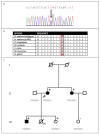Mutation analysis of the phospholamban gene in 315 South Africans with dilated, hypertrophic, peripartum and arrhythmogenic right ventricular cardiomyopathies
- PMID: 26917049
- PMCID: PMC4808831
- DOI: 10.1038/srep22235
Mutation analysis of the phospholamban gene in 315 South Africans with dilated, hypertrophic, peripartum and arrhythmogenic right ventricular cardiomyopathies
Erratum in
-
Corrigendum: Mutation analysis of the phospholamban gene in 315 South Africans with dilated, hypertrophic, peripartum and arrhythmogenic right ventricular cardiomyopathies.Sci Rep. 2016 May 18;6:25863. doi: 10.1038/srep25863. Sci Rep. 2016. PMID: 27189347 Free PMC article. No abstract available.
Abstract
Cardiomyopathy is an important cause of heart failure in Sub-Saharan Africa, accounting for up to 30% of adult heart failure hospitalisations. This high prevalence poses a challenge in societies without access to resources and interventions essential for disease management. Over 80 genes have been implicated as a cause of cardiomyopathy. Mutations in the phospholamban (PLN) gene are associated with dilated cardiomyopathy (DCM) and severe heart failure. In Africa, the prevalence of PLN mutations in cardiomyopathy patients is unknown. Our aim was to screen 315 patients with arrhythmogenic right ventricular cardiomyopathy (n = 111), DCM (n = 95), hypertrophic cardiomyopathy (n = 40) and peripartum cardiomyopathy (n = 69) for disease-causing PLN mutations by high resolution melt analysis and DNA sequencing. We detected the previously reported PLN c.25C > T (p.R9C) mutation in a South African family with severe autosomal dominant DCM. Haplotype analysis revealed that this mutation occurred against a different haplotype background to that of the original North American family and was therefore unlikely to have been inherited from a common ancestor. No other mutations in PLN were detected (mutation prevalence = 0.2%). We conclude that PLN is a rare cause of cardiomyopathy in African patients. The PLN p.R9C mutation is not well-tolerated, emphasising the importance of this gene in cardiac function.
Figures


References
-
- Elliott P. et al. Classification of the cardiomyopathies: a position statement from the european society of cardiology working group on myocardial and pericardial diseases. Eur Heart J 29, 270–276 (2008). - PubMed
Publication types
MeSH terms
Substances
Grants and funding
LinkOut - more resources
Full Text Sources
Other Literature Sources

